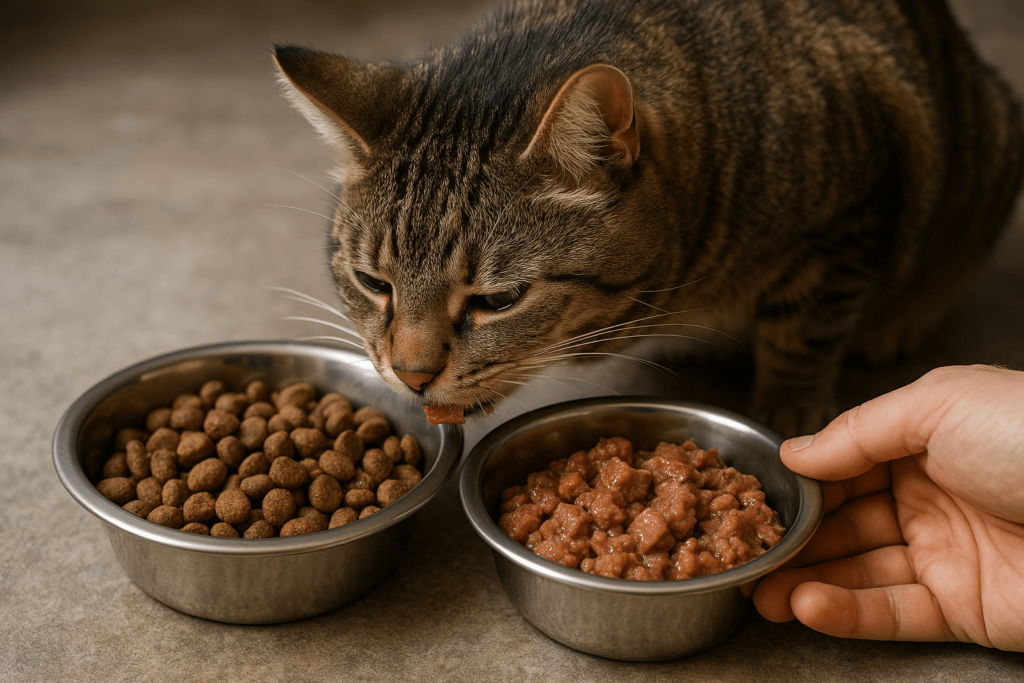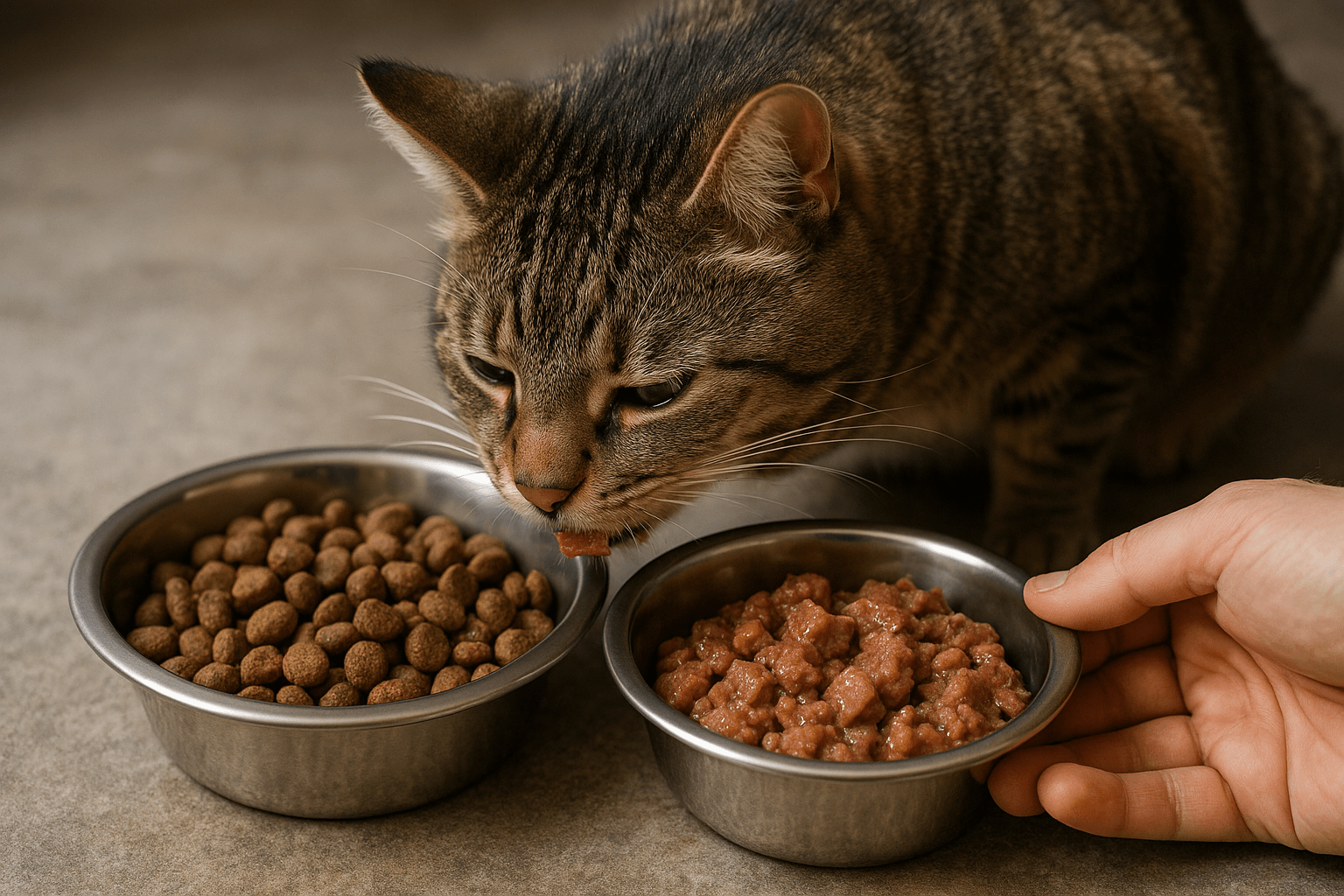Why Feed Your Cat Wet and Dry Food? The Science Behind the Bowl
Feeding your cat wet and dry food isn’t just a matter of convenience — it’s a decision that impacts their hydration, digestion, longevity, and overall happiness. Cats are obligate carnivores with biological needs that modern kibble alone often fails to meet. Yet, dismissing dry food entirely ignores its practical benefits. The key? Balance. Understanding why to feed wet and dry food — and how to do it right — transforms feeding time from a chore into a cornerstone of feline wellness. In this guide, we’ll explore the science, the strategies, and the subtle signs that tell you when your cat’s diet is working — or when it’s time to change.
The Core Reasons Cats Need Both Wet and Dry Food
Cats don’t eat out of preference alone — they eat out of instinct. Their bodies are wired for a specific nutritional profile, and the combination of wet and dry food helps meet those needs more completely than either alone.
Hydration is Non-Negotiable:
Cats evolved to get most of their water from prey. Wet food delivers 70–80% moisture, helping prevent chronic dehydration — a silent killer linked to kidney disease and urinary crystals.Protein Quality Matters:
High-quality wet food typically contains more animal-based proteins and fewer fillers than budget dry kibble, aligning with your cat’s carnivorous biology.Dental Engagement Isn’t Just About Crunch:
While dry food offers mild abrasion, it doesn’t clean teeth effectively. But when paired with wet food, it provides texture variety that keeps oral muscles active.Palatability Drives Intake:
Wet food’s aroma and texture stimulate appetite — critical for seniors, sick cats, or picky eaters who might otherwise under-eat.Portion Control and Routine Support Stability:
Dry food allows for free-feeding or timed dispensers, creating structure — while wet food ensures meals are intentional, nutrient-dense events.
When you combine both, you’re not just feeding your cat — you’re supporting their physiology from the inside out.

The Health Benefits of Wet Food for Your Cat
Wet food isn’t a treat — it’s preventive medicine in a pouch. Its high moisture and low-carb profile make it one of the most beneficial dietary choices for domestic cats.
Reduces Risk of Urinary Tract Disease:
Diluted urine from high water intake minimizes crystal formation and prevents blockages — a leading cause of emergency vet visits.Supports Kidney Function:
Chronic dehydration stresses the kidneys. Wet food eases this burden, especially vital for older cats prone to renal decline.Improves Digestion and Gut Health:
Easier to digest than dry kibble, wet food reduces gastrointestinal upset and promotes regular bowel movements.Helps Manage Weight and Diabetes:
Lower in carbohydrates and higher in protein, wet food helps regulate blood sugar and prevents insulin resistance — a major factor in feline diabetes.Boosts Appetite in Aging or Ill Cats:
Stronger smell and softer texture make wet food irresistible to cats with diminished senses or dental pain.
Feeding wet food regularly isn’t optional for most cats — it’s a lifeline. Studies show cats on wet diets have significantly lower rates of lower urinary tract disease and better long-term kidney markers.
Check this guide 👉Understanding Cat Food Calories: Best 7 Expert Tips!
Check this guide 👉Understanding Cat Food Macros: Best 7 Expert Tips!
Check this guide 👉How Long Does Cat Food Last in the Fridge? Best 7 Tips!
| Wet Food Benefits | Dry Food Benefits |
|---|---|
| High moisture supports kidney and urinary health | Convenient for free-feeding and busy lifestyles |
| Lower carbohydrate levels reduce diabetes risk | Crunchy texture may help reduce mild plaque buildup |
| Improved palatability for picky or senior cats | Generally more affordable per calorie |
| Easier digestion for cats with dental issues | Long shelf life without refrigeration |
| Higher concentration of animal-based proteins and taurine | Ideal for use in food puzzles and interactive feeders |
The Practical Advantages of Dry Food in a Balanced Diet
Dry food has earned its place — not as the main course, but as a strategic tool. When used wisely, it enhances convenience without compromising health.
Convenience for Busy Households:
Dry food stays fresh at room temperature, making it ideal for owners who work long hours or travel frequently.Supports Mental Stimulation:
Puzzle feeders and slow-feeders work brilliantly with dry kibble, turning mealtime into an engaging mental game.Cost-Effective Nutrition:
Per calorie, premium dry food often costs less than wet — a practical advantage for multi-cat homes or tight budgets.Texture Variety Promotes Oral Engagement:
The slight abrasion from chewing kibble can help reduce plaque buildup between professional cleanings.Easier to Measure and Portion:
Precise calorie control is simpler with dry food, helping prevent overfeeding and obesity — one of the most common feline health issues.
Think of dry food as a supplement: a tool for structure, not substance. It works best when paired with wet meals that provide the hydration and protein your cat truly needs.
Common Myths About Wet and Dry Cat Food — Debunked
The pet food industry thrives on myths. Don’t let marketing cloud your judgment. Here’s what you really need to know.
“Dry Food Cleans Teeth” — Not True:
Most cats swallow kibble whole. The crunch doesn’t reach below the gumline. Dental health requires brushing, not kibble.“Grain-Free Means Healthier” — Misleading:
Many grain-free foods replace grains with peas, potatoes, or lentils — all high-carb fillers that spike blood sugar. Look for meat-first, not label buzzwords.“Cats Don’t Need Water If They Eat Wet Food” — Dangerous:
Even with wet food, cats still need fresh water. Hydration is cumulative — never assume one source is enough.“More Expensive = Better Quality” — Not Always:
Price doesn’t guarantee nutrition. Always check the ingredient list: first three should be named meats (chicken, fish, turkey), not “meat by-products.”“My Cat Likes Dry Food, So It Must Be Best” — A Trap:
Cats adapt to what’s offered. That doesn’t mean it’s optimal. With patience, even the pickiest cats can learn to love wet food.
Feed based on biology — not advertising.
How to Balance Wet and Dry Food for Your Cat’s Age and Health
There’s no one-size-fits-all ratio. Your cat’s life stage, activity level, and medical history determine the ideal mix.
Kittens (0–12 months):
Feed 70% wet, 30% dry. Wet food supports growth, hydration, and easy chewing. Use dry as a snack or puzzle feeder supplement.Adult Cats (1–7 years):
Aim for 60–70% wet, 30–40% dry. This balance supports weight, urinary health, and energy needs without overfeeding.Senior Cats (8+ years):
Prioritize 80–90% wet food. Kidney function declines with age — moisture is critical. Choose low-phosphorus, high-protein formulas.Cats with Urinary Issues:
100% wet food is often recommended by vets. Dry food increases risk of blockages and crystals.Overweight or Diabetic Cats:
Feed mostly wet food with controlled dry portions. Low-carb, high-protein formulas are essential — avoid all grain-based kibble.
Track your cat’s weight, litter box habits, and energy. Adjust as needed. Flexibility saves lives.
Signs Your Cat’s Diet Isn’t Working
Your cat can’t tell you they’re dehydrated or bloated — but their body will. Watch for these red flags.
Frequent Urination or Straining:
A sign of urinary discomfort — often caused by low moisture intake.Dry, Brittle Fur or Dull Coat:
Poor hydration and low-quality protein show up in coat condition.Weight Gain Despite Portion Control:
Dry food is calorie-dense. Too much can lead to obesity, even with small portions.Bad Breath or Drooling:
Could indicate dental disease or gastrointestinal upset from poor digestion.Refusing Wet Food or Eating Less Overall:
A sign of underlying illness, food aversion, or unappetizing formula.
If you notice these signs, reevaluate your feeding strategy — and consult your vet. Early intervention prevents serious health decline.
How to Transition Your Cat from Dry to Wet Food — Step by Step
Many cats resist change. But with patience, even the most kibble-obsessed feline can learn to love wet food.
Start Small:
Mix 1 teaspoon of wet food into their usual dry meal. Gradually increase the wet portion over 7–10 days.Warm It Up:
Gently heat wet food to body temperature (microwave for 5 seconds) to enhance aroma — cats are drawn to warmth.Use a Shallow Dish:
Avoid deep bowls. Cats prefer eating from wide, flat surfaces where they can see their surroundings.Try Different Textures:
Some cats prefer pâté, others like chunks in gravy. Experiment with flavors: chicken, turkey, tuna, or rabbit.Be Patient — Don’t Force It:
If your cat refuses, remove the food after 20 minutes. Try again at the next meal. Never leave wet food out all day.
Transitioning isn’t about winning a battle — it’s about guiding your cat toward better health. Celebrate every bite.
Frequently Asked Questions About Feeding Wet and Dry Food
Why does my cat only eat dry food and ignore wet food?
Your cat may be used to the texture or flavor. Try warming the wet food, mixing it with a bit of tuna juice, or switching brands until you find a preferred texture.
Can I leave dry food out all day?
Yes — if your cat maintains a healthy weight. But replace it daily to avoid staleness or contamination. Use a covered dispenser if possible.
Is it okay to mix wet and dry food in the same bowl?
Only if served immediately. Wet food becomes soggy and unappealing if left mixed for long. Serve separately for best results.
Does wet food cause bad breath?
No. Bad breath usually signals dental disease, not wet food. In fact, wet food is gentler on sensitive teeth and gums.
How much wet food should I feed daily?
Most adult cats need 2–4 oz of wet food per 5 lbs of body weight, split into two meals. Always check the feeding guide on the specific brand and adjust based on your cat’s activity and weight.
Embrace the Balance — Feed with Purpose, Not Convenience
Feeding your cat wet and dry food isn’t about choosing sides — it’s about honoring their biology. They didn’t evolve to eat kibble. They evolved to hunt, to hydrate from prey, to stretch, to mark, to thrive on protein-rich, moisture-packed meals. By blending the convenience of dry food with the life-sustaining benefits of wet food, you’re not just feeding them — you’re protecting them. You’re giving them the hydration their kidneys need, the protein their muscles crave, and the mental stimulation their instincts demand. A happy cat isn’t one who eats what’s easy — it’s one who eats what’s right. And that starts with the bowl you fill today.
Canned Pumpkin for Cat Diarrhea: Best 7 Expert Tips! Natural remedy to firm stools, soothe upset bellies, and support gut health safely.
Can a Cat Give You Scabies? Best 7 Expert Tips! Discover the truth about feline mites, human skin risks, and how to protect yourself—without panic.
Cat Flea vs Human Flea: Best 7 Expert Tips! Discover the truth about bites, species, and how to eliminate infestations for good.
Weird Cat Behaviors: Best 7 Expert Tips! Discover why cats do strange things—and how to understand, not punish, their instincts for a happier home.





